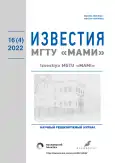The rechargeable systems of electric energy storage for the category L vehicles
- Authors: Degtyarev I.P.1, Kurmaev R.H.1
-
Affiliations:
- State Scientific Center of the Russian Federation “NAMI”
- Issue: Vol 16, No 4 (2022)
- Pages: 357-363
- Section: Electrotechnical complexes and systems
- URL: https://journals.rcsi.science/2074-0530/article/view/126644
- DOI: https://doi.org/10.17816/2074-0530-108564
- ID: 126644
Cite item
Full Text
Abstract
BACKGROUND: The high-tech world cannot be stable essentially, therefore there are electric automobiles, electric motorcycles and other vehicles with the electric energy source alongside conventional vehicles. Due to the development of category L electric vehicles, development and manufacturing of rechargeable systems of electric energy storage (RSEES) is demanded. The design of the system of electric energy storage must meet a number of requirements given to category L electric vehicles. The system of electric energy storage as part of an electric vehicle should ensure the maximal drive range (high energy capacity) and have enough strength of ensuring the safety of a category L vehicle. One of the issues of meeting the given requirements is reducing the mass of the RSEES frame using light-alloy materials.
AIMS: Increase of energy efficiency of the two-wheeled vehicle with an electric drive based on development of the RSEES considering mass and dimensional properties.
METHODS: One of the methods of modelling the structural elements of a frame with similar geometrical layout but using various materials (nonferrous materials) is used. The theoretical simulation of loading at these structural elements and comparison of components with various materials are performed.
RESULTS: The issue of reducing the mass of the RSEES is one of the problems of improvement the category L electric vehicles (EV) efficiency. Apart from increase of drive range, reducing the mass and inertial properties of the RSEES frame leads to improvement of maneuvering ability and handling of an EV. It is worth noting that the location of the rechargeable systems of electric energy storage inside an electric motorcycle positively affects energy efficiency because of lowering the center of mass, which consequently reflects on aerodynamics and driving of category L electric vehicle.
CONCLUSIONS: The main current issue of development of the RSEES for electric vehicles including electric motorcycles is reducing its mass. One of the ways of achieving it is using variable alloys in the RSEES frame design. The method of calculation of the design of the frame of the rechargeable system of electric energy storage which allows optimal choosing of material and component geometry, that makes possible to reduce mass and dimensional properties by 20%, is shown in the article. The next stage is manufacturing of a prototype and practical testing of the PSEES for confirmation of the theoretical calculations.
Full Text
##article.viewOnOriginalSite##About the authors
Ivan P. Degtyarev
State Scientific Center of the Russian Federation “NAMI”
Author for correspondence.
Email: iIvan.degtyarev@nami.ru
ORCID iD: 0000-0001-5378-6578
Chief Design Engineer of the Information and Intelligent Systems Center
Russian Federation, 2 Automotornaya street, 125438 MoscowRinat H. Kurmaev
State Scientific Center of the Russian Federation “NAMI”
Email: rinat.kurmaev@nami.ru
ORCID iD: 0000-0001-7064-0466
SPIN-code: 6483-2444
Cand. Sci. (Tech.), Associate Professor, Director of the Research and Education Center
Russian Federation, 2 Automotornaya street, 125438 MoscowReferences
- Razelli E. Prospects for Lead-Acid Batteries in the New Millennium. Journal of Power Sources. 2003;116(1–2):2–3. doi: 10.1016/S0378-7753(02)00675-4
- Anderman M. Brief Assessment of Improvements in EV Battery Technology since the BTAP June 2000 Report. Needham: Advanced Automotive Batteries; 2003. Available from: https://www.tech-insider.org/electric-vehicles/research/acrobat/030327-2.pdf accessed: 05.06.2022.
- Cherry C, Cervero R. Use Characteristics and Mode Choice Behavior of Electric Bike Users in China. Transport Policy. 2007;14(3):247-257. doi: 10.1016/j.tranpol.2007.02.005
- Stroganov VI. Povyshenie ekspluatatsionnykh kharakteristik elektromobiley i avtomobiley s kombinirovannoy energoustanovkoy [dissertation] Moscow; 2014. Available from: http://d21221704.samgtu.ru/sites/d21221704.samgtu.ru/files/dissertaciya_stroganov_18.10.14.pdf accessed: 05.06.2022. (in Russ).
- Ospanbekov BK. Povyshenie energeticheskoy effektivnosti i ekspluatatsionnykh pokazateley elektromobiley [dissertation] Moscow; 2017. Available from: https://miit.ru/content/%D0%94%D0%B8%D1%81%D1%81%D0%B5%D1%80%D1%82%D0%B0%D1%86%D0%B8%D1%8F.pdf?id_wm=770923 accessed: 05.06.2022. (in Russ).
- Feng L, Jiang Y, Chen S. Problem Analysis and Policy Options for Electric Bicycle Development. Strategy Study of Urban Transport Development in China. Beijing: Center for Sustainable Transportation, China Academy of Transportation Sciences; 2007.
- Patent RUS № 2563576 / 20.09.2015 Byul. № 26. Khambittser G, Khaytbaum I, Bork M, et al. Batareynaya ustanovka vysokoy moshchnosti i sposob upravleniya batareynoy ustanovkoy vy-sokoy moshchnosti. Available from: https://new.fips.ru/iiss/document.xhtml?faces-redirect=true&id=f4b0cfdb6790fa15fc7993d8b8650fe4 accessed: 05.06.2022. (in Russ).
- Patent RUS № 2589530 / 10.07.2016 Byul. № 19. U S, Van Kh, Se Sh. Silovaya ustanovka elektromobilya, elektromobil i sposob obogreva akkumulyatornoy batarei elektromobilya. Available from: https://new.fips.ru/iiss/document.xhtml?faces-redirect=true&id=34c4a21238de7148541fc03021e8f7a3 accessed: 05.06.2022. (in Russ).
- Patent RUS № 2570242 / 10.12.2015 Byul. № 34. Venger U, Koler BR, Yenni Kh-R. Elektromobil i zaryadnoe ustroystvo bortovogo akkumulyatora dlya etogo elektromobilya. Available from: https://new.fips.ru/iiss/document.xhtml?faces-redirect=true&id=c013f0ff0c9dd3f5d2d73806c45b0827 accessed: 05.06.2022. (in Russ).
Supplementary files












